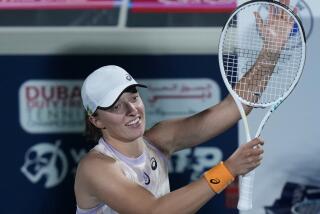U.S. Open Tennis Championships : Leconte, France’s Blithe Spirit, Loses to Lendl
- Share via
NEW YORK — The future of French tennis is in the hands of a rosy-cheeked, dimpled elf of a guy whose behavior on court is similar to a schoolboy’s at recess.
Henri Leconte is impulsive, impetuous and the fastest-rising star on the Gallic horizon. Watching Leconte play tennis is one of the genuine pleasures at this year’s U.S. Open. Even when he loses, as he did Wednesday in the quarterfinals, he is delightful.
Leconte caused top-seeded Ivan Lendl to drop a set for the first time in the tournament, but he lost to Lendl, 7-6, 6-1, 1-6, 6-1. C’est la vie, seems to be Leconte’s attitude. It was fun while it lasted.
Leconte’s emergence is just another in a line for France. The French these days are taking their tennis almost as seriously as their food. Virtually all the French pros are products of tennis schools operated by the French Tennis Federation.
As in the American tennis academies, young French tennis players live away from home at these national centers, where they also attend school.
Yannick Noah is one such case. Noah was discovered by Arthur Ashe, who was on a good-will tour of Cameroon, the African nation where Noah’s family was living. When Noah came to France at the age of 10, he was immediately enrolled in a tennis school and stayed there for several years.
At the moment, there are four French players on the tour. The Four Musketeers, as they are called in France, have done well. Noah is ranked No. 6, Leconte is No. 8, Thierry Tulasne is No. 12 and Guy Forget is No. 36.
There is a distinct camaraderie among the French. They often travel together and practice together. The French Davis Cup team has had success largely because the top French players take time off the tour to play for France.
Like the Swedes, the French as a group are often viewed in stereotypical terms: “The French players don’t work hard, they socialize too much, they aren’t competitive enough, they don’t care if they win or lose, they play with great style . . . “
It’s only partly true. Noah, perhaps the best athlete on the tour, has an excellent work ethic, although Leconte is indifferent to practice. “When he works hard, he gets good results,” one French sportswriter said. “But sometimes he forgets to work.”
Unlike the Swedes, who don’t seem to relish competition, the French are fiercely competitive. Yet, unlike the Americans, the French players are happy enough to be the best they can be, even if that doesn’t mean No. 1 in the world.
Noah is the foremost proponent of the Greta Garbo syndrome popularized by the Swedes--”I want to be alone.” It’s often harder for Mats Wilander to talk to reporters than it is to play a five-set match against Lendl.
Noah was so besieged by proud French fans after winning the French Open in 1983 that he moved to New York, where even the mayor gets no attention.
Noah made it clear in what came to be known as his “stress conferences” that he doesn’t care for the pressure of the public eye.
Leconte, on the other hand, is like the little kid who always raises his hand in class, snapping his fingers, begging to be called on. After a match, Leconte often seeks out a tour press liaison, smiles a toothy grin, and says, “Press?”
And the press loves it. Leconte is goofy, unpredictable and very often quite funny. That’s in English. In French, say the French reporters, Leconte is “Not so funny. More like stupid.” Ion Tiriac, who has coached Leconte, used to call him “the idiot.”
Leconte is called the court jester with reason. In Wednesday’s match, Leconte saluted a lineswoman who, finally, had made a call he liked. He will talk to anyone within earshot, and some who aren’t. While he yammers away he may wave his arms around or roll his eyes.
Lendl says Leconte is difficult to play because of his capricious nature.
“He’s so dangerous, he’s scary,” Lendl said. “When I’m thinking about him, I’m thinking about him as a mad Frenchman, in a nice way, because he’s like a madman out on the court. You can hit a first serve to his forehand as hard as you can--you may never see the ball. You can’t even question the call because that’s how fast it comes back.
“He’s really nice, don’t get me wrong. I’m not saying he’s nasty or anything. I’m just saying he plays like a madman. He can make great shots and he can make terrible shots. “
Leconte’s erratic performances have hindered him. Early this year, when he was playing with little zest, his questions were answered with a blood test--mononucleosis. From January to mid-May, Leconte played in only two tournaments.
He’s back with his regular practice schedule, which will likely increase his stamina. Leconte is also a more settled person, a family man. His wife, Brigitte, is 12 years his senior--he’s 23--and thought to have instilled the calm that was missing in his life.
Open Notes In women’s singles quarterfinal action Wednesday, No. 2 Chris Evert Lloyd defeated No. 9 Manuela Maleeva, 6-2, 6-2, and No. 7 Helena Sukova defeated unseeded Wendy Turnbull, 6-4, 6-0. . . . In the other men’s quarterfinal, No. 4 Stefan Edberg of Sweden beat the last American, Tim Wilkison, 6-3, 6-3, 6-3 . . . This is the first year in two decades that only one American, Wilkison, has advanced to the quarterfinal round of the U.S. Open. The last time was 1966, when Clark Graebner lost in the quarterfinals to Fred Stolle.
More to Read
Go beyond the scoreboard
Get the latest on L.A.'s teams in the daily Sports Report newsletter.
You may occasionally receive promotional content from the Los Angeles Times.











